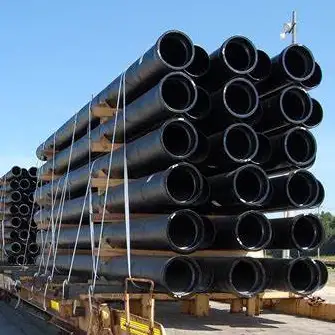ASTM A395 is a standard specification developed by ASTM International for ferritic ductile iron castings intended for pressure-retaining parts used at elevated temperatures. These castings are primarily used in applications where resistance to high temperatures and pressure is essential. The standard specifies the requirements for chemical composition, mechanical properties, and other factors to ensure the material’s suitability for its intended use.

1. Chemical Composition of ASTM A395
The chemical composition of ASTM A395 ductile iron is critical to its performance characteristics. The standard specifies the following elemental requirements:
-
Carbon (C): Minimum 3.00%
-
Silicon (Si): Maximum 2.50%
-
Phosphorus (P): Maximum 0.08%
These elements contribute to the material’s strength, machinability, and resistance to elevated temperatures. The carbon content is particularly important for the formation of graphite nodules, which enhance the ductility of the iron. Silicon aids in the formation of graphite and improves casting fluidity, while phosphorus can impact the material’s machinability and is therefore limited.
2. Mechanical Properties and Performance
ASTM A395 ductile iron exhibits several key mechanical properties:
-
Tensile Strength: Minimum 60,000 psi (414 MPa)
-
Yield Strength: Typically around 40,000 psi (276 MPa)
-
Elongation: Approximately 18% to 30%
-
Hardness: Typically in the range of 170 to 220 Brinell
These properties make ASTM A395 suitable for applications requiring high strength and resistance to thermal expansion and contraction. The material’s ductility allows it to absorb energy and deform without fracturing, which is advantageous in pressure-retaining components.
3. Equivalent Materials Across Standards
ASTM A395 has several equivalents in other international standards, reflecting its global applicability:
| Standard | Equivalent Grade | Notes |
|---|---|---|
| ASTM A395 | 60-40-18 | Primary grade specified in the standard |
| EN-GJS-400-18 | EN 1563 | European equivalent |
| GGG-40.3 | DIN 1693 | German equivalent |
| FCD400-18L | JIS G5502 | Japanese equivalent |
These equivalents share similar chemical compositions and mechanical properties, ensuring that ASTM A395 can be substituted with confidence in international applications.
4. Applications of ASTM A395
Due to its high strength and resistance to elevated temperatures, ASTM A395 is used in various applications:
-
Pressure Vessels: Components that operate under high pressure and temperature conditions.
-
Valves and Valve Bodies: Especially in steam and water systems.
-
Flanges and Pipe Fittings: In industries like oil and gas, power generation, and chemical processing.
-
Compressors and Turbines: Parts that require durability under thermal cycling.
The material’s ability to withstand thermal stresses and maintain structural integrity makes it ideal for these demanding applications.
5. Manufacturing and Casting Processes
The production of ASTM A395 ductile iron involves several key steps:
-
Melting: The base iron is melted in an induction furnace.
-
Inoculation: Magnesium is added to promote the formation of nodular graphite.
-
Pouring: The molten metal is poured into molds to form the desired shapes.
-
Cooling: Controlled cooling rates are maintained to achieve the desired microstructure.
-
Machining: Post-casting machining is performed to achieve final dimensions and surface finish.
These processes ensure that the final product meets the stringent requirements of ASTM A395.
6. Heat Treatment and Surface Finishing
To enhance the properties of ASTM A395 ductile iron, heat treatment processes such as stress relieving and annealing may be applied. These treatments help to reduce internal stresses and improve machinability. Surface finishing techniques, including shot blasting and coating, are also employed to improve corrosion resistance and surface appearance.
7. Corrosion Resistance and Durability
ASTM A395 ductile iron exhibits good resistance to corrosion, particularly in environments where exposure to elevated temperatures is common. The ferritic matrix contributes to its durability, allowing it to perform reliably over extended periods. However, in highly corrosive environments, additional protective coatings or alloying elements may be necessary to enhance its resistance.
8. Frequently Asked Questions (FAQs)
Q1: What is the significance of the carbon content in ASTM A395?
The carbon content in ASTM A395 is crucial for the formation of graphite nodules, which impart ductility to the material. A minimum carbon content of 3.00% ensures that the iron has sufficient carbon to form these nodules, enhancing its ability to deform without fracturing under stress.
Q2: How does ASTM A395 compare to other ductile iron grades?
Compared to other ductile iron grades, ASTM A395 has a lower tensile strength but higher ductility, making it suitable for applications where resistance to thermal expansion and contraction is critical. Grades like ASTM A536 offer higher strength but may lack the same level of ductility.
Q3: Can ASTM A395 be used in cryogenic applications?
ASTM A395 is designed for elevated temperature applications and may not perform optimally at cryogenic temperatures. For cryogenic applications, materials with better low-temperature properties, such as certain austenitic stainless steels, are recommended.
Q4: What are the advantages of using ASTM A395 in pressure-retaining components?
The high ductility of ASTM A395 allows pressure-retaining components to absorb energy and deform without fracturing, which is advantageous in applications subjected to thermal cycling and pressure fluctuations.
Q5: Are there any limitations to using ASTM A395?
While ASTM A395 offers excellent ductility and thermal resistance, its tensile strength is lower than some other ductile iron grades. Therefore, it may not be suitable for applications requiring maximum strength.
Q6: How does the manufacturing process affect the properties of ASTM A395?
The manufacturing process, including melting, inoculation, pouring, and cooling, directly influences the microstructure and properties of ASTM A395. Controlled processes ensure the formation of the desired ferritic matrix and graphite nodules, optimizing the material’s performance.
For more detailed information on ASTM A395 and its applications, refer to the official ASTM A395/A395M-99(2018) standard.
